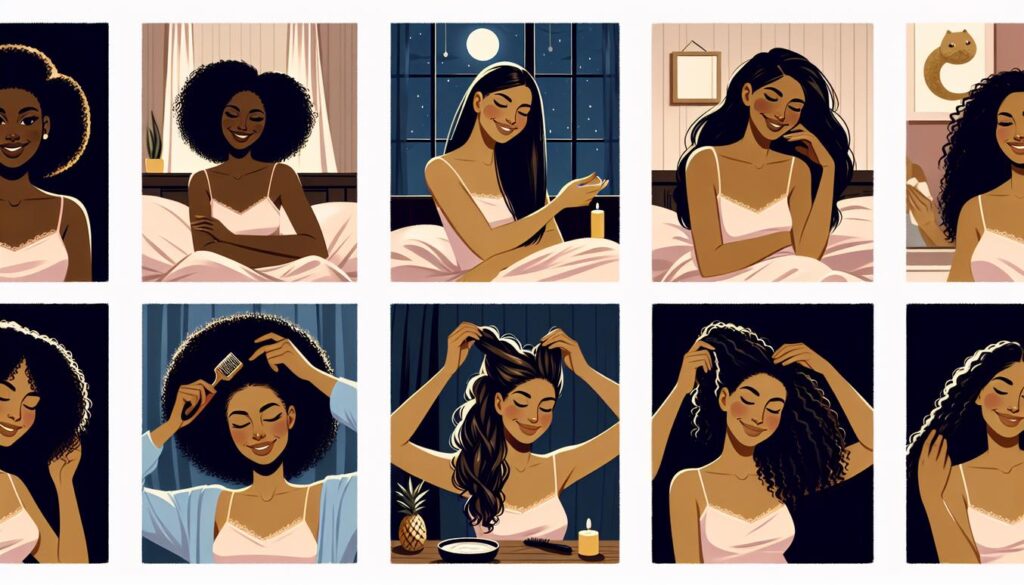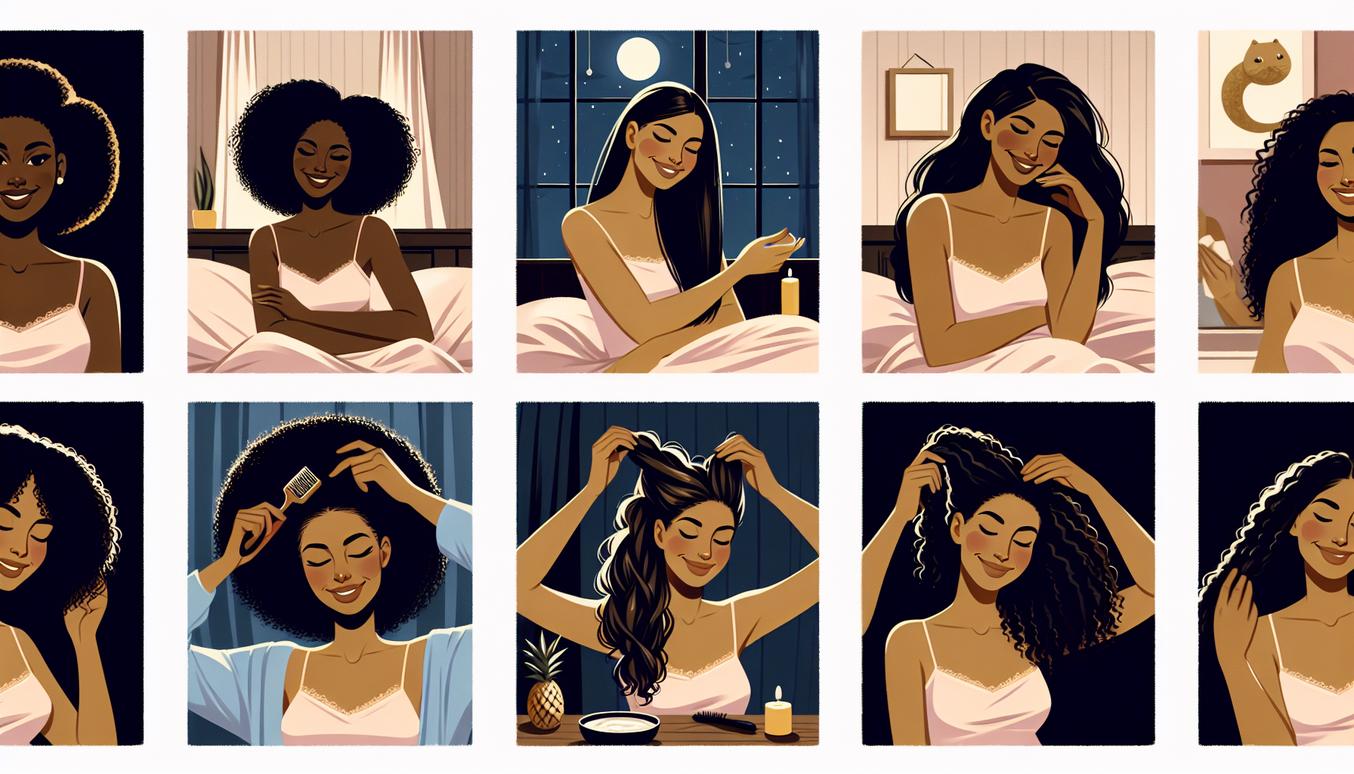Introduction — Why caring for hair at night yields noticeable benefits
You spend about a third of your life asleep, so why not make that time work for your hair? While you rest, your hair is rubbing against pillows, getting tangled, and losing moisture. This is where a dedicated overnight hair care routine comes in. It is not about adding complex, time-consuming steps to your evening. Instead, it is about making small, intentional adjustments that protect your hair, lock in moisture, and reduce morning styling stress. Think of it as beauty sleep, but specifically for your tresses.
The benefits are hard to ignore. A consistent nightly hair routine can lead to less breakage, reduced frizz, better moisture retention, and hair that is easier to manage when you wake up. By investing just a few minutes before bed, you are setting the stage for healthier, more resilient hair in the long run. This guide is designed for busy adults and beginners, breaking down simple yet effective overnight hair care strategies for every hair type.
How hair behaves overnight: the basics explained
To understand the importance of overnight hair care, it helps to know what your hair goes through while you sleep. The primary culprit for damage is friction. As you toss and turn, your hair strands rub against your pillowcase, roughing up the hair’s protective outer layer, known as the cuticle. When the cuticle is lifted, hair loses moisture, becomes frizzy, and is more prone to tangling and breaking.
Furthermore, your body is in a state of repair and regeneration at night. This includes processes that support hair health. According to hair growth research, the cell division that contributes to hair growth is highly active during rest. A healthy scalp environment and protected strands can support these natural cycles. By implementing a protective nightly routine, you are not just preventing damage; you are creating an optimal environment for your hair to thrive.
Pre sleep checklist: products and preparation
Getting started with overnight hair care does not require a complete overhaul of your cabinet. A few key items can make a world of difference. Before you begin, ensure you have the right tools and products on hand for your hair type.
Essential Tools:
- Silk or Satin Pillowcase: A non-negotiable for reducing friction. The smooth surface allows hair to glide, preventing snags and breakage.
- Gentle Hair Ties: Ditch the tight elastic bands. Opt for scrunchies (especially silk or satin ones) or spiral hair ties that will not create harsh creases or pull on your hair.
- Satin Scarf or Bonnet: These provide a complete barrier of protection, keeping your hair contained, moisturized, and safe from friction.
- Wide-Tooth Comb or Detangling Brush: To gently remove knots before you apply products or style your hair for sleep.
Helpful Products:
- Leave-In Conditioner: A lightweight spray or cream to add a layer of moisture and protection.
- Hair Oil or Serum: To seal the hair cuticle, lock in moisture, and add shine. A little goes a long way.
- Dry Shampoo: For those with oily hair, a light application at the roots before bed can help absorb excess oil overnight.
Overnight routines by hair type
The most effective overnight hair care routine is one that is tailored to your specific hair needs. What works for fine, straight hair may not be suitable for thick, coily hair. Here are some simple, customized routines you can adopt starting tonight.
Straight hair: lightweight hydration and gentle protection
The main goals for straight hair are to prevent tangles and avoid weighing it down. A heavy-handed approach can leave it looking greasy by morning.
- Preparation: Gently brush your hair from ends to roots to remove all tangles.
- Product: Apply a small amount of a lightweight serum or a few drops of a light oil (like argan or grapeseed oil) to the mid-lengths and ends only.
- Style: Secure your hair in a loose braid or a low, loose ponytail with a scrunchie. This prevents tangles without creating kinks.
Wavy hair: preserve texture while reducing frizz
For wavy hair, the challenge is to protect the wave pattern from being flattened or becoming frizzy. The right overnight hair care can help you wake up with defined, soft waves.
- Preparation: If your hair is damp, gently scrunch in a small amount of wave cream or mousse. If dry, you can lightly mist it with water.
- Product: A light leave-in conditioner can help maintain moisture.
- Style: The “pineapple” method is a game-changer. Gather your hair into a very high, loose ponytail on top of your head, secured with a scrunchie. This protects the length of your waves from being crushed while you sleep.
Curly hair: moisture locking and pillowproof styling
Curls thrive on moisture, and overnight is the perfect time to replenish it. Protecting the curl pattern is equally crucial to avoid a frizzy, undefined morning look.
- Preparation: Refresh your curls with a mix of water and leave-in conditioner in a spray bottle.
- Product: Apply a curl cream to help with definition and lock in moisture.
- Style: In addition to the “pineapple” method, consider protecting your hair with a satin bonnet or scarf. For extra definition, you can re-twist larger curl clumps before putting on your bonnet.
Coily hair: deep moisture and low manipulation methods
Coily and kinky hair types are the most fragile and prone to dryness, making a dedicated overnight hair care routine essential for length retention and health.
- Preparation: Section your hair to ensure even product distribution.
- Product: Use the LOC (Leave-in, Oil, Cream) or LCO (Leave-in, Cream, Oil) method to layer products for maximum moisture retention.
- Style: Protective styles like two-strand twists, braids, or Bantu knots are ideal. They protect your ends, prevent tangles, and stretch your coils gently. Always cover your style with a satin scarf or bonnet.
Fine or thinning hair: volume friendly night care
The key for fine hair is protection without sacrificing volume. Heavy products and tight styles are the enemy.
- Preparation: Gently detangle your hair to avoid any pulling on the roots.
- Product: Use products sparingly. A very light root-lifting spray or volumizing mist can be applied before styling. Avoid oils and creams near the scalp.
- Style: A loose bun on the very top of your head, secured with a silk scrunchie, can help maintain volume at the roots. A silk pillowcase is a must to prevent breakage.
Thick or coarse hair: detangling and nourishment strategies
Thick hair can handle richer products and needs strategies to remain manageable and hydrated.
- Preparation: Detangle your hair thoroughly in sections using a wide-tooth comb.
- Product: Do not be afraid to use a nourishing hair butter or a richer leave-in cream, focusing on the ends.
- Style: A single, thick braid or two loose braids can keep hair contained and prevent it from becoming a tangled mess overnight.
DIY overnight treatments and simple formulas
You do not need expensive products to give your hair an overnight boost. Your kitchen likely holds the ingredients for a simple, effective treatment. Use these once a week for an extra dose of nourishment.
- For Hydration (All Hair Types): Mix two parts aloe vera gel with one part of your favorite lightweight oil (like jojoba or almond oil). Apply to damp hair, cover with a sleep cap, and rinse in the morning.
- For a Healthy Scalp: Brew a strong cup of chamomile or green tea, let it cool completely, and transfer it to a spray bottle. Lightly mist your scalp before bed to soothe irritation.
- For Shine and Strength: Lightly warm a tablespoon of coconut or olive oil. Massage it gently into the ends of your hair. This simple treatment helps seal split ends and adds a beautiful sheen.
Protective sleep techniques: pillowcases, scarves and sleep styles
The physical barrier between your hair and your bedding is a cornerstone of overnight hair care. Cotton pillowcases, while comfortable, are highly absorbent and can sap moisture from your hair. Their rougher texture also creates significant friction.
This is why switching to a smoother fabric is so important. Research on silk sleep textile benefits suggests that its smooth surface can reduce friction on both skin and hair. Satin offers a similar, more budget-friendly alternative.
Your choice of sleep style also plays a crucial role:
- The Loose Braid: Excellent for straight and wavy hair to prevent tangles.
- The Pineapple: Ideal for wavy, curly, and coily hair to protect curl patterns. Gather hair into a very high, loose ponytail.
- Twists or Braids: Perfect for coily and curly types to lock in moisture and prevent knots.
- The Loose Top Knot: A great option for fine or straight hair to maintain root volume.
For maximum protection, especially for curly and coily hair, pairing a protective style with a satin bonnet or scarf is the gold standard. This encases the hair completely, locking in moisture and eliminating all friction.
Morning recovery routine and quick styling tips
An effective overnight hair care routine should make your mornings easier, not harder. After a night of protection, your hair will need minimal effort to look its best.
- Take Down Gently: Carefully undo your braid, bun, or twists. Avoid yanking or pulling.
- Shake it Out: Flip your hair over and use your fingers to gently shake out the roots to restore volume and shape.
- Refresh and Rehydrate: For curly and wavy types, a light mist of water or a curl refreshing spray can revive your pattern. Use your fingers to scrunch and reshape.
- Tame Flyaways: For straight hair, smooth a tiny drop of serum or oil over any frizzy areas. You can also spray a bit of hairspray onto a brush and gently comb it over the top layer of your hair.
- Add Volume: If your roots look a little flat, a quick blast with a blow dryer on a cool setting can lift them back up.
Common mistakes that undo overnight care
Even with the best intentions, a few common missteps can sabotage your overnight hair care efforts. Be mindful to avoid these:
- Sleeping with Soaking Wet Hair: Hair is at its most fragile when wet. While damp styling is fine, going to bed with dripping hair can lead to breakage and potential scalp issues.
- Using Tight, Damaging Hair Ties: Tight elastic bands create tension and can cause breakage right at the tie-off point. Always opt for soft, loose options like scrunchies.
- Applying Too Much Product: More is not always better. Overloading your hair with heavy oils or creams can lead to greasy, weighed-down locks in the morning. Start with a small amount and add more only if needed.
- Forgetting to Detangle First: Putting your hair up for the night without first removing knots will only lead to a bigger, more damaging tangles in the morning.
Ingredient spotlight: oils, humectants and keratin
Understanding the key ingredients in your products can elevate your overnight hair care routine. Here are three power players to look for:
- Oils: Natural oils are fantastic for hair health. They can be broken down into two main types. Moisturizing oils, like coconut and olive oil, can penetrate the hair shaft. Sealing oils, like jojoba and argan oil, sit on the outside of the hair shaft, locking in moisture and adding shine. As highlighted in studies on natural oils and hair health, they play a significant role in protecting hair from damage.
- Humectants: These are ingredients that attract water from the atmosphere and draw it into the hair shaft. Common humectants include glycerin, hyaluronic acid, and panthenol. They are excellent for combating dryness, especially in leave-in conditioners and mists.
- Keratin: Your hair is primarily made of a protein called keratin. Products containing hydrolyzed keratin can temporarily patch gaps in the hair cuticle, helping to strengthen the strand, reduce frizz, and improve elasticity.
Seven night plan template and habit checklist
Building a new habit takes consistency. Use this simple one-week template for your overnight hair care to get started. This plan is designed to be achievable, even for a 2025 busy lifestyle.
| Night | Action (5 Minutes or Less) | Check When Done |
|---|---|---|
| Night 1: Foundation | Gently detangle hair. Put into a loose protective style (braid/bun). Sleep on a silk/satin pillowcase. | ☐ |
| Night 2: Lightweight Moisture | Detangle. Apply 2-3 drops of a lightweight serum or oil to your ends. Style and protect. | ☐ |
| Night 3: Scalp Care | Spend 2 minutes gently massaging your scalp with your fingertips to stimulate blood flow. Style and protect. | ☐ |
| Night 4: Refresh | Repeat Night 1. Consistency is key. | ☐ |
| Night 5: Deep Treatment | Apply a simple DIY mask or a store-bought overnight treatment. Cover with a bonnet or cap. | ☐ |
| Night 6: Wash Day Prep | If you wash your hair in the morning, apply a pre-shampoo oil treatment to your ends. Style and protect. | ☐ |
| Night 7: Simple Protection | Give your hair a break from products. Simply detangle, put it in a loose style, and protect. | ☐ |
Troubleshooting common issues and FAQs
My hair feels greasy or weighed down in the morning. What am I doing wrong?
This is a common issue and usually comes down to one of two things: using too much product or applying it too close to your roots. Start with a pea-sized amount for your entire head, focusing only on the mid-lengths and ends. You can always add more, but you cannot take it away without washing.
Can I practice overnight hair care every single night?
Yes, absolutely! The protective elements, like sleeping on a satin pillowcase and using a loose hairstyle, should be done every night. However, more intensive treatments like deep conditioning masks or heavy oils should be limited to once or twice a week, depending on your hair’s needs.
Will a bonnet or scarf mess up my hairstyle?
Quite the opposite! A well-fitting bonnet or scarf is designed to protect your style. For voluminous styles, look for large or extra-large bonnets that allow your hair to sit comfortably without being crushed. If you have curls, a bonnet is one of the best ways to preserve definition and prevent frizz.
Conclusion and a simple nightly routine for busy schedules
Embracing an overnight hair care routine is one of the most efficient ways to achieve healthier, more manageable hair. By protecting your strands from friction and locking in moisture while you sleep, you are minimizing damage and cutting down on morning styling time. The key is consistency and tailoring the approach to your unique hair type.
If you are short on time, start with this simple, two-minute routine:
- Brush: Gently detangle your hair with a wide-tooth comb or brush.
- Protect: Secure your hair in a loose braid or top knot with a silk scrunchie.
- Glide: Sleep on a silk or satin pillowcase.
Even this minimal effort, performed consistently, will yield noticeable improvements in the health and appearance of your hair. Make your sleep work for you, and wake up to a better hair day, every day.





